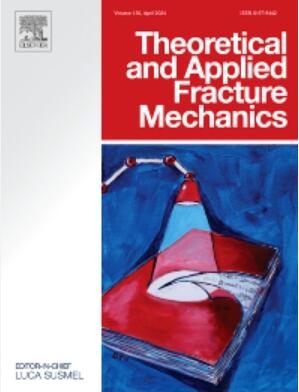Experimental study on mode I fracture response of adhesive joints subjected to systematic creep damage
IF 5
2区 工程技术
Q1 ENGINEERING, MECHANICAL
引用次数: 0
Abstract
Structural adhesive joints are effective strategy for constructing lightweight, cost-efficient components. Evaluating their long-term performance is crucial for designing durable and robust bonded systems. Understanding time-dependent phenomena like creep and its impact on the mechanical and fracture behavior of adhesives provides valuable insights for improved design. Creep loading significantly influences the strength, deformation, and fracture response of bonded structures over their service life. This study investigates the creep behavior and mode I fracture response of modified double-cantilever beam (MDCB) adhesive joints subjected to sustained tensile loads, focusing on two primary factors: creep stress level and creep duration. Creep tests were conducted on MDCB specimens at stress levels of 20 %, 30 %, 40 %, 50 %, and 60 % of the adhesive’s maximum tensile strength () for durations of 12, 48, and 72 h. The aim was to assess how sustained creep affects the residual fracture properties of adhesive joints. Creep behavior was characterized by analyzing strain vs. time curves, identifying elastic, primary, and secondary creep stages. Results showed that joints tolerated 20–40 % of for a maximum creep duration of 72 h. Subsequently, mode I fracture after creep (FAC) tests were performed on MDCB joints exposed to 20–40 % at a crosshead speed of 0.5 mm/min. FAC tests revealed a significant reduction in fracture load and fracture energy with increasing creep stress levels and durations compared to control specimens without creep exposure. Fracture surface analysis indicated a transition from cohesive failure to a combination of adhesive and cohesive failure with longer creep durations. Finally, a semi-empirical model was developed using response surface methodology (RSM) to predict the residual mode I fracture energy of adhesive joints, enabling future numerical simulations of creep behavior.
求助全文
约1分钟内获得全文
求助全文
来源期刊

Theoretical and Applied Fracture Mechanics
工程技术-工程:机械
CiteScore
8.40
自引率
18.90%
发文量
435
审稿时长
37 days
期刊介绍:
Theoretical and Applied Fracture Mechanics'' aims & scopes have been re-designed to cover both the theoretical, applied, and numerical aspects associated with those cracking related phenomena taking place, at a micro-, meso-, and macroscopic level, in materials/components/structures of any kind.
The journal aims to cover the cracking/mechanical behaviour of materials/components/structures in those situations involving both time-independent and time-dependent system of external forces/moments (such as, for instance, quasi-static, impulsive, impact, blasting, creep, contact, and fatigue loading). Since, under the above circumstances, the mechanical behaviour of cracked materials/components/structures is also affected by the environmental conditions, the journal would consider also those theoretical/experimental research works investigating the effect of external variables such as, for instance, the effect of corrosive environments as well as of high/low-temperature.
 求助内容:
求助内容: 应助结果提醒方式:
应助结果提醒方式:


